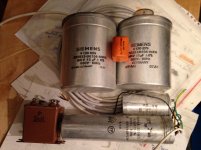You're right, I'm wrong
I remember JBL paralleling a small capacitor of 10nF instead of 100 nF.
Best regards!
EDIT: See the N-3134 schematics in the upper part of my pic 🙂!
Hence a question may arise: Was JBL the first to propagate paralleling smaller capacitors to bigger ones? What's the real benefit of this?
Beste regards!
Beste regards!
The benefit was to counteract the inductive rise of larger capacitors. It's also not as much of an issue today using film caps.
Wolf
Wolf
So I went ahead, but got scared, chickened out, because of the sizes.
So I went for 15uF red 4 cm MKT's I have available too in the old box. Wound in anti-inductive way. The result was great (already), sibilance gone. But also more pronounced high frequency in general, balance of harmonics was 'new', you have to learn the new balance.
My wife likes it, that is a good thing.
I should try to adapt the circuit a bit.
The old 15uF bipolar electrulytics (ROE Germany, from 1979) caps looked good, but one strange thing: they meased differently in one direction than in the reverse direction. 16,5 one way, 14,9 the other way, while my cap tester only sends out AC. Might have to do with forming of the dielectic. Good grief.
That implies that in a signal the polarity that changes thousands of times a sec, also changes the polarisation. . . .
- yes I had at hand MKV 15 uF - is 15 cm dia
- and 15uf motor run combination - is 25cm high - . .
So I went for 15uF red 4 cm MKT's I have available too in the old box. Wound in anti-inductive way. The result was great (already), sibilance gone. But also more pronounced high frequency in general, balance of harmonics was 'new', you have to learn the new balance.
My wife likes it, that is a good thing.
I should try to adapt the circuit a bit.
The old 15uF bipolar electrulytics (ROE Germany, from 1979) caps looked good, but one strange thing: they meased differently in one direction than in the reverse direction. 16,5 one way, 14,9 the other way, while my cap tester only sends out AC. Might have to do with forming of the dielectic. Good grief.
That implies that in a signal the polarity that changes thousands of times a sec, also changes the polarisation. . . .
Attachments
Last edited:
